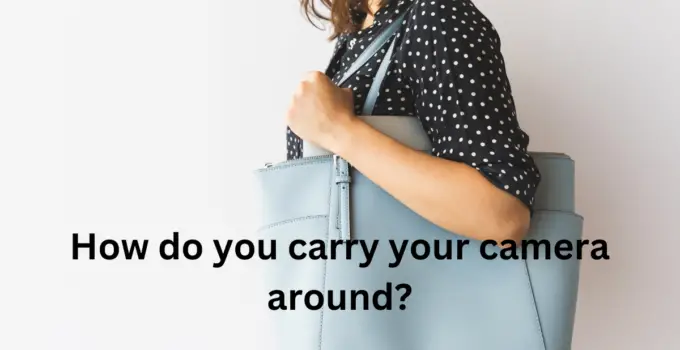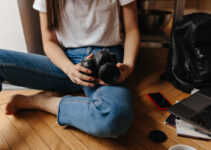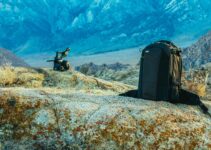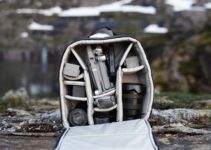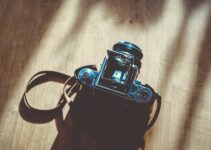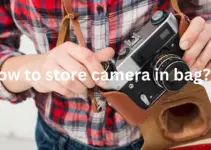As a photographer or vlogger, you probably have to carry your camera around pretty often. And if you’re traveling, you might want to bring along a few extra lenses or other gear. So how do you carry your camera around? Here are a few tips…
I always carry my camera in a padded case whenever I go out, even if I’m just going for a walk around the block. I’ve had too many cameras, and lenses get damaged by impacts or scratches, so I’ve learned my lesson.
The case has a strap that I can wear over my shoulder or across my body, and it has a quick-access flap so I can get to the camera quickly if I need to.
I also always make sure to keep a lens cloth handy, so I can clean the lens if it gets dirty. Taking care of your camera gear is essential if you want it to last.
Let’s take a look at a few ways to carry your camera around.
Ready?
5 Ways To Carry Your Photography Equipment
You will be glad after knowing these 5 ways to carry your camera equipment without feeling fearful.
1. Camera Neck Straps
I always use a camera neck strap. It’s just more comfortable for me than carrying it around in my hands all the time.
And I like having the option to quickly grab it and take a picture when I see something I want to capture.
Plus, I feel like it helps to distribute the camera’s weight more evenly, so my neck and shoulders don’t get as tired.
Some people think that camera neck straps are bulky and inconvenient, but I disagree. I think they’re actually quite handy and make it easier to keep track of your camera.
2. Camera Holsters
I’m a big fan of camera holsters. I find them to be the most comfortable and convenient way to carry my camera around, especially when I’m out hiking or doing other activities where I don’t want to lug a heavy camera bag around.
The main benefit of a holster is that it keeps your camera readily accessible so you can quickly grab it and start shooting when the moment strikes.
Another advantage is that it helps to distribute the camera’s weight evenly, which can make a big difference when carrying it around all day.
Finally, many holsters come with additional features like rain covers and lens pouches, which can be very handy when you’re out in the field.
Whether you’re a casual shooter or a professional photographer, I think you’ll find that a camera holster is a great way to keep your gear safe and within easy reach.
3. Camera bag:
I used just to throw my camera in my purse, but then I realized that wasn’t the best way to protect such an expensive investment.
Now I have a dedicated camera bag that I carry with me whenever I go somewhere that might be photo-worthy.
It’s big enough to fit my DSLR body, a couple of lenses, and all the other little accessories I need, but not so big and bulky that it’s a pain to lug around.
And it has a special padded compartment for my camera, so I know it’s well-protected. I love my camera bag and would never go back to throwing my camera in my purse!
4. A hard case
I always carry my camera in a hard case. It’s important to me that my gear is well-protected, especially since I do a lot of travel photography.
I’ve had too many experiences where I’ve seen other photographers’ cameras get damaged because they weren’t properly stored.
In a hard case, I know that my camera will be safe from bumps, scratches, and changes in temperature or humidity. Plus, it’s easy to transport a hard case –
I can just throw it in my car’s trunk or suitcase when I’m going on a trip. For me, the extra peace of mind is worth the extra effort of carrying a hard case around.
4. Wrist strap:
I often get asked how I carry my camera around, and the answer is usually pretty simple: wrist straps. Wrist straps are an essential piece of photography gear, and they come in handy in various situations.
For example, when taking pictures at a concert or event, I always have my wrist strap attached to my camera. That way, if I drop my camera or it gets knocked over, it’s not going to hit the ground hard and possibly break.
Additionally, wrist straps are great for keeping your camera safe and close by when you’re not using it. I’ve had times when I’ve set my camera down for a minute and then realized that I don’t know where I left it.
But with a wrist strap, you can just put the camera around your wrist and know that it’s not going anywhere. So if you’re looking for a convenient and affordable way to carry your camera, consider getting a wrist strap.
Related FAQ’s
How To Carry Your Camera Without A Bag?
Whether you’re an amateur photographer or a professional, one of the most important things to consider when taking pictures is how you’re going to carry your camera.
A lot of people opt for using a camera bag, but this can be bulky and difficult to manage, especially if you’re also carrying other items. Fortunately, there are other options for carrying your camera.
One option is to use a camera strap. This can be attached directly to the camera body or lens, allowing you to wear the camera around your neck or shoulder. This is a relatively straightforward way to carry your camera, and it’s ideal for quick shots. Another option is to use a camera case.
This can provide more protection for your camera and usually has additional storage space for things like batteries and memory cards.
Camera cases come in a variety of designs, so you should be able to find one that suits your needs.
Finally, if you’re only carrying a few items, you may be able to get away with just carrying your camera in your hand.
This isn’t always the safest option, but it can be helpful if you’re just running into somewhere quickly to take a few pictures. No matter how you choose to carry your camera, always remember to keep it safe and protected from the elements.
How To Carry Heavy Camera Equipment?
Any photographer will tell you that lugging around a heavy camera and all of its accessories is no easy feat. Here are a few tips on how to best carry your camera gear so that you can make the most of your photo shoot without ending up with aching arms or a sore back.
First, invest in a good camera bag with padded straps and several compartments for holding your equipment. Second, try to distribute the weight evenly by carrying the bag over both shoulders.
And finally, if you’re going to be carrying your gear for an extended period of time, consider using a rolling cart or trolley to take some of the strain off of your body.
By following these simple tips, you’ll be able to focus on getting great shots instead of worrying about your hurting muscles.
How Should You Carry Your Camera And Photography Equipment?
When it comes to carrying your camera and photography equipment, there are a few things to keep in mind. First, always use a case or bag that is specifically designed for photographic equipment.
This will help to protect your gear from bumps, scratches, and other damage. Second, distribute the weight evenly between your shoulders and hips.
This will help you avoid strain on any part of your body. And finally, be sure to take regular breaks to rest your arms and shoulders. By following these simple tips, you can ensure that you’ll be able to keep shooting all day long.
How do you carry a video camera?
There are a few things to remember when carrying a video camera. First, be sure to hold the camera steady and keep your arms close to your body.
This will help to minimize shaking and produce smoother footage. Second, be mindful of your surroundings and be careful not to bump into anything or anyone.
Third, try to keep the camera as level as possible; tilting the camera can often result in dizzying or disorienting footage.
Finally, don’t be afraid to experiment with different angles and perspectives; sometimes, the best shots come from unexpected places. By following these simple guidelines, you can help ensure that your video footage is of the highest quality.
Conclusion:
I typically carry my DSLR camera in a low-epic camera bag. It is comfortable to wear and has room for all of my camera equipment.
I also have a tripod that I often carry with me. I used to carry my camera in a backpack, but it was too cumbersome and often got in the way.
The low-epic camera bag is a perfect size and doesn’t weigh me down. Plus, it has a lot of compartments for extra lenses and batteries. I can also easily access my camera when it’s in the bag.
Whether hiking, biking, or just walking around town, I always have my camera with me to capture those spontaneous moments.

